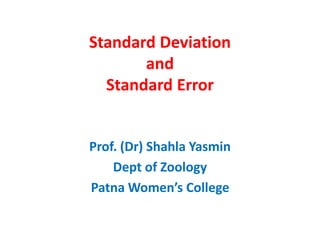
Standard Deviation and Standard Error Explained
- 1. Standard Deviation and Standard Error Prof. (Dr) Shahla Yasmin Dept of Zoology Patna Women’s College
- 2. Learning objectives The students will learn about : • Range and variability • Standard deviation • Calculation of standard deviation from ungrouped and grouped data • Variance • Standard error of mean • Confidence limits of the mean
- 3. Range and variability • Variation occurs in the populations, so the samples (e.g measurement of height, weight, length etc) collected from the population shows variability. • Simplest measure of variability in a sample is called range. • Range takes into account only the two most extreme observations of the sample. So it can be used where measurements are few. Its use is limited. • e. g. height of girls (n=10) in the ranges from 4ft to 5.5ft
- 4. Standard deviation • First introduced by Karl Pearson in 1893 • Standard deviation is a fundamental property of Normal probability curve, 68.26% of the observations is included by one standard deviation on either side of the axis of symmetry (=mean). • Therefore, standard deviation is a very useful comparative measure of variation about a mean value of sample. • If sample includes the entire population, the symbol of standard deviation is σ (sigma). It is calculated by the formula σ = √ ∑ (x- μ )2/N • Where, x = value of observation μ = population mean ∑ = the sum of N = number of sampling units in the population
- 5. Standard deviation • It is rare to collect sample from the entire population. So samples are collected from a portion of a population. In this case, symbol σ is replaced by ‘s’. The formula for calculating s becomes • s = √ ∑ (x- x̅)2 /n-1 • Where x̅ = sample mean • n = number of sampling units in the sample. • (x- x̅ ) = deviation from the mean
- 6. Calculation of standard deviation of ungrouped data 1. Calculate the mean (simple average of the numbers). 2. For each number: subtract the mean. Square the result. 3. Add up all of the squared results. 4. Divide this sum by one less than the number of data points (n - 1). 5. Take the square root of this value to obtain the sample standard deviation .
- 7. Calculation of standard deviation • Following is the wing length measurements (mm) • 81,79,82,83,80,78,80,87, 82,82 1. Mean x̅ = ∑ x/n =814/10 =81.40 mm 2. (81-81.4)2 = 0.16 (79-81.4)2 = 5.76 (82-81.4)2 = 0.36 (83-81.4)2 = 2.56 (80-81.4)2 = 1.96 (78-81.4)2 = 11.56 (80-81.4)2 = 1.96 (87-81.4)2 = 31.36 (82-81.4)2 = 0.36 (82-81.4)2 = 0.36 3. ∑ (x- x̅)2 = sum of squares of deviations = 56.4
- 8. Calculation of standard deviation of ungrouped data 4. Sum of squares/n-1 = ∑ (x- x̅)2 /n-1 =56.4/9 = 6.27 5. Standard deviation s = √6.27 = 2.50 mm
- 9. Calculation of standard deviation from grouped data • Formula for standard deviation of grouped data is • s = √ ∑ f (x- x̅)2 /n-1 • Wing length measurements: • Calculation continued on next slide…..
- 10. Calculation of standard deviation from grouped data Class (x) mm Frequency f (x- x̅)2 f (x- x̅)2 68 1 36 36 69 2 25 50 70 4 16 64 71 7 9 63 72 11 4 44 73 15 1 15 74 20 0 0 75 15 1 15 76 11 4 44 77 7 9 63 78 4 16 64 79 2 25 50 80 1 36 36 ∑ f (x- x̅)2 = 544 n = 100 s = √ ∑ f (x- x̅)2 /n-1 = √544/99 = √5.49 =2.34 mm
- 11. Variance • Variance is the square of standard deviation • Conversely, standard deviation is the square root of variance • s = √s2, and • s2 = ∑ (x- x̅)2 /n-1
- 12. Standard Error of Mean • Standard error of the mean (SEM) measures how far a sample mean deviates from the actual mean of a population • S.E. = sample standard deviation/√number of sampling units • S.E. calculated from previous data of wing length=2.34/√100 = 2.34/10 = 0.234
- 13. Confidence limits of the mean • The standard error of the mean shows how good is the estimate that the sample mean is close to population mean. • Referring to the normal distribution curve, We are 68% confident that population mean lies within ± 1 S.E. of sample mean. • We want to be more sure, so 95% or 99% limits are generally used. These can be obtained by multiplying S.E. (standard error) by z score (of Normal probability curve) • 95% of observations fall within ± 1.96 S.E (z= ± 1.96). • 99% of observations fall within ± 2.58 S.E (z= ± 2.58). • The intervals ± 1.96 S.E and ± 2.58 S.E are called 95% and 99% confidence limits respectively. • 95% confidence limits of wing lengths are 74± (1.96X0.234) =74.00±0.459